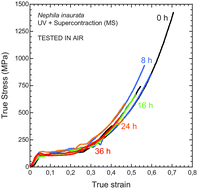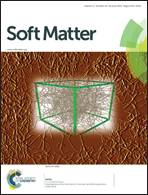Unexpected behavior of irradiated spider silk links conformational freedom to mechanical performance†
Abstract
Silk fibers from Argiope trifasciata and Nephila inaurata orb-web weaving spiders were UV irradiated to modify the molecular weight of the constituent proteins. Fibers were characterized either as forcibly silked or after being subjected to maximum supercontraction. The effect of irradiation on supercontraction was also studied, both in terms of the percentage of supercontraction and the tensile properties exhibited by irradiated and subsequently supercontracted fibers. The effects of UV exposure at the molecular level were assessed by polyacrylamide gel electrophoresis and mass spectrometry. It is shown that UV-irradiated fibers show a steady decrease in their main tensile parameters, most notably, tensile strength and strain. The combination of the mechanical and biochemical data suggests that the restricted conformational freedom of the proteins after UV irradiation is critical in the reduction of these properties. Consequently, an adequate topological organization of the protein chains emerges as a critical design principle in the performance of spider silk.


 Please wait while we load your content...
Please wait while we load your content...